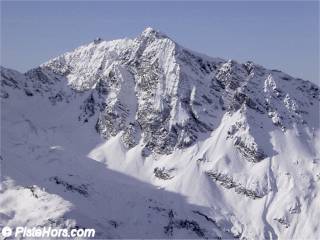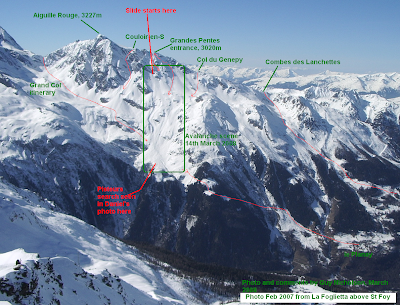Alain Duclos also witnessed a large avalanche on the Pointe d’Andagne in Bonneval Sur Arc in the Maurienne. The slide was triggered by a snowboarder under the Andagne chair. The victims were able to ride out the slide thanks to good technique.
http://www.data-avalanche.org/alea_avalanches/view_item/Avalanche/50000176
I have a large resolution picture of the Aiguille Rouge slide if anyone would like it. It’s taken from accross the valley in Ste Foy where I had spent the week. The crown wall (in 3 places) is clearly visible, as are 2 other smaller slides way over to the left of the main slide. At the very bottom of the slide (unfortunately too small to be clearly distinguishable) is a group of up to approximately 30 rescuers in a line arcing from left up to the right. Many of them were pisteurs flown in from Ste Foy and other resorts in the valley.
This is Daniel’s photo:
If you click on the link you can view a larger version. The slide has broken under rocks and also in the two couloirs. I think these slopes are slightly north-east oriented so probably stay colder than slopes directly to the east.
A few things can happen in this configuration. The snow-pack can be thinner on the rocks as snow tend sluff off. A thin snow-pack has a stronger temperature gradient (zero degrees at ground level) which can lead to the formation of weak snow crystals - these are large angular grains you often see on north sector slopes after a few weeks of cold weather.
Also snow sluffing can lead to slab formation under the steeper slopes. The irregular rock shapes can form stress points in the snowpack.
That said there is nothing particular to say that this route could not be skied other than the risks outlined in the bulletin (The Munter Method would surely have warned against such a slope that day). You can see the rescue team at the very bottom of this very big avalanche. Both skiers were found after around 1h15-1h30 under the snow (burial depth 150cm and 100cm) due to surface indications. The police report doesn’t mention if they were wearing beacons. I tend to think not given the time of burial but that is speculation. The departure point was a 35° slope.
I have marked up the scene using a photo I took across the valley last winter. The photo shows the terrain the avalanche covered - from the slide to where the pisteurs are seen in Daniel’s photo is at least 800m in altitude. Poor lads.
We skied the same slope in the first week of February this year with two off-duty ski patrollers from Les Arcs. Photos from that day are here - the first three photos are the Grandes Pentes taking exactly the same fall-line as the avalanche on 14th March:
http://shinycoolgnu.blogspot.com/2008/02/february-week-skiing-in-les-arcs.html
The third photo of Philippe taking a call is the reverse perspective of Daniel’s photo - you can see St Foy behind. In this photo we are just below where the line of pisteurs are making the search. Philippe replied to a text from me on 15th March - he was one of the pisteurs making the search in Daniel’s photo.
I’ll be back in Villaroger the second week of April, and hoping that this latest snow has stabilized by then… There’s a working plan to do a ski tour on the glaciers in the Vanoise national park near Pralognan ![]()


